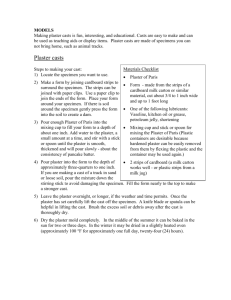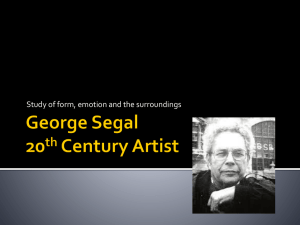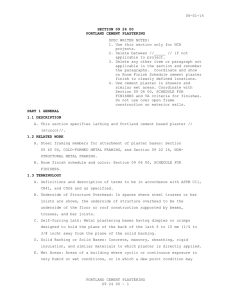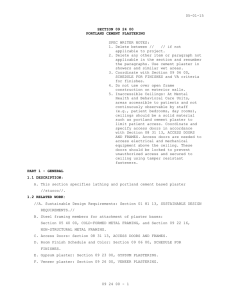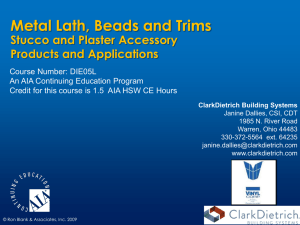GUIDE SPECIFICATION
advertisement
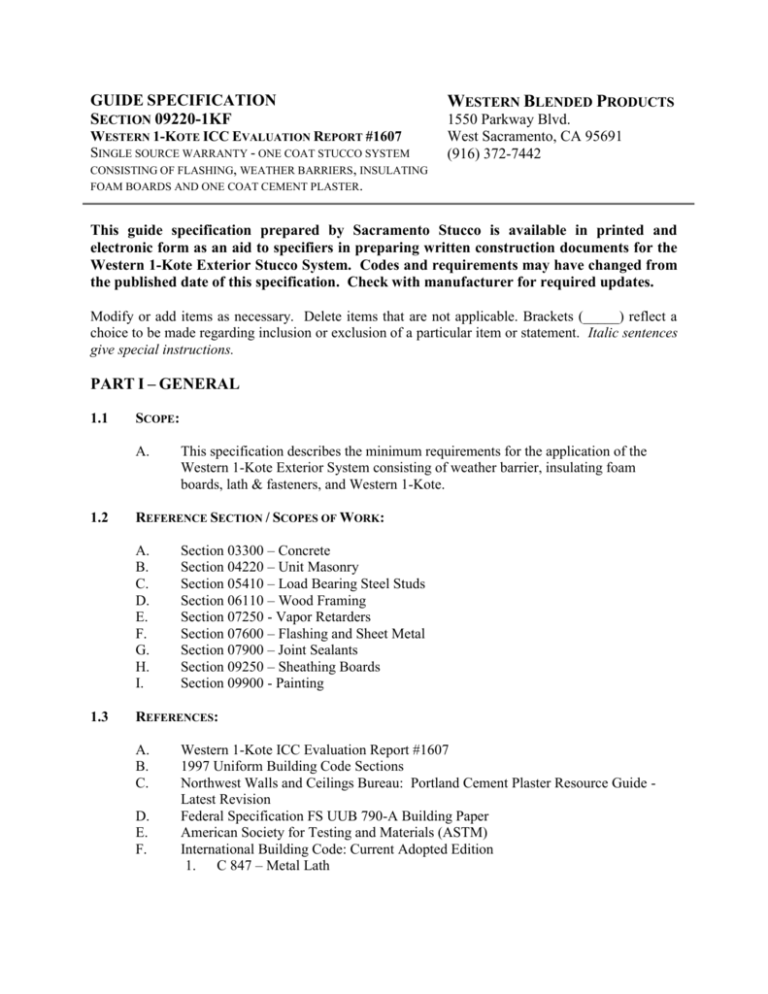
GUIDE SPECIFICATION SECTION 09220-1KF WESTERN 1-KOTE ICC EVALUATION REPORT #1607 SINGLE SOURCE WARRANTY - ONE COAT STUCCO SYSTEM CONSISTING OF FLASHING, WEATHER BARRIERS, INSULATING FOAM BOARDS AND ONE COAT CEMENT PLASTER. WESTERN BLENDED PRODUCTS 1550 Parkway Blvd. West Sacramento, CA 95691 (916) 372-7442 This guide specification prepared by Sacramento Stucco is available in printed and electronic form as an aid to specifiers in preparing written construction documents for the Western 1-Kote Exterior Stucco System. Codes and requirements may have changed from the published date of this specification. Check with manufacturer for required updates. Modify or add items as necessary. Delete items that are not applicable. Brackets (_____) reflect a choice to be made regarding inclusion or exclusion of a particular item or statement. Italic sentences give special instructions. PART I – GENERAL 1.1 SCOPE: A. 1.2 REFERENCE SECTION / SCOPES OF WORK: A. B. C. D. E. F. G. H. I. 1.3 This specification describes the minimum requirements for the application of the Western 1-Kote Exterior System consisting of weather barrier, insulating foam boards, lath & fasteners, and Western 1-Kote. Section 03300 – Concrete Section 04220 – Unit Masonry Section 05410 – Load Bearing Steel Studs Section 06110 – Wood Framing Section 07250 - Vapor Retarders Section 07600 – Flashing and Sheet Metal Section 07900 – Joint Sealants Section 09250 – Sheathing Boards Section 09900 - Painting REFERENCES: A. B. C. D. E. F. Western 1-Kote ICC Evaluation Report #1607 1997 Uniform Building Code Sections Northwest Walls and Ceilings Bureau: Portland Cement Plaster Resource Guide Latest Revision Federal Specification FS UUB 790-A Building Paper American Society for Testing and Materials (ASTM) International Building Code: Current Adopted Edition 1. C 847 – Metal Lath 2. 3. 4. 5. 6. 1.4 C 897 – Specification for Aggregate for Job-Mixed Portland Cement-Based Plasters. C 926 – Specification for Application of Portland Cement-Based Plaster. C 1063 – Specification for Installation of Lathing and Furring to Receive Interior and Exterior Portland Cement-Based Plaster. C 834 / C 920 Sealants E 119 – Test Method for Fire Tests of Building Construction Materials. SYSTEM DESCRIPTION: Weather barrier, woven, welded or expanded metal lath reinforcement, insulating foam boards, Western 1-Kote Concentrate or sanded basecoat, and Western stucco or Western Premium Acrylic Finish Elastomeric (PAF-E). 1.5 QUALITY ASSURANCE: A. Obtain cement plaster, stucco/synthetic finish, lath, fasteners and trim that comply of the Western 1-Kote Exterior Stucco System B. Manufacturer: Sacramento Stucco or approved blenders of Western 1-Kote. C. Contractor shall provide trained personnel qualified to install lath weather barrier, insulating foam boards, plaster and finishes per the scope of work described in this specification. 1.6 DELIVERY, STORAGE AND HANDLING: A. B. C. D. 1.7 SITE CONDITIONS: A. 1.8 Deliver, store, handle, and protect products for use on the project. Deliver product to job site: 1. Without exposure to weather or other sources of moisture. 2. In manufacturer’s unopened container, packages or bundles; clearly identified. Store in dry, ventilated space off of the ground. Protect materials from soiling, rusting and damage. Contractor shall have reasonable and safe access to the jobsite for delivery, staging, storing, mixing and application of materials required for the described scope of work. ENVIRONMENTAL CONDITIONS: A. Cold Weather Requirements: Provide heat and protection, temporary or permanent, as required to protect each coat of plaster from freezing – during or at least 24 hours after application or longer – to insure curing of the base and finish coats without freezing. Distribute heat uniformly to prevent concentration of heat on plaster near heat sources; provide deflection or protective screens. (Use of Xccelerate Cold Weather NON-Chloride additive is permissible.) B. Warm Weather Requirements: Protect plaster against uneven and excessive evaporation and from strong flows of dry air, both natural and artificial. Apply and moist cure plaster to prevent dry out during the first forty-eight (48) hours or longer as required by climatic conditions. Provide suitable coverings, moist curing, barriers to deflect sunlight and wind, or combinations of these as required. 1.9 C. Application Requirements: Apply plaster when substrate or ambient air temperature is 40 degrees F and rising (unless sand and mixing water are heated to 70 degrees F and temporary protection is provided to keep minimum 40 degrees F or above in plastered areas for 24 hours minimum after set has occurred in accordance with PCA Portland Cement Plaster Stucco Manual. Do not use frozen materials in mixes and do not apply materials to frozen bases. D. Protection: Protect finished surface installed prior to plastering by covering with suitable drop cloths. When application of cement plaster is to interior spaces, screen openings with plastic film when building is subject to hot, dry winds, or when temperature differentials between interior and exterior spaces of more than 20 degrees F are present. SEQUENCING: A. B. C. D. E. F. G. H. I. The General Contractor shall coordinate communications between the trades and scheduling of the work prior to project commencement and while the work is in progress. Consult other trades in advance and make provisions for their work to avoid cutting and patching. Applicator of the Cement Plaster System shall schedule all inspections required by local authorities or product manufacturers, at each required stage, before continuing with the next stage of the system. All wall penetrations shall be installed with proper flashing details by the appropriate trades before lathing shall begin. Flashing materials shall be compatible with sealant, building paper and flashings installed for the lath. Attachment of drywall or other products to the interior sides of walls receiving Western 1-Kote shall be complete before the installation of the exterior cement plaster. Tile, Stone or other roofing materials of significant weight shall be loaded onto roof before application of exterior cement plaster. Adequately moist cure Western 1-Kote. (Apply required leveling coats and primers.) Attach specification 09220-BPS (Apply acrylic finish coat.) Attach specification 09220-PAF PART II – PRODUCTS 2.1 MANUFACTURERS: A. B. C. D. E. F. Sacramento Stucco Company, West Sacramento, CA. Western Stucco Company, Glendale, AZ. Rio Grande Stucco Company, El Paso, TX Ash Grove Packaging, Precision Packaging, Materials Packaging Dow, Western Insulfoam, AFP or equal. Fortifiber G. H. I. 2.2 WEATHER BARRIER, LATH AND TRIM MATERIALS: A. B. C. D. E. F. G. 2.3 Clark Western, Cemco or equal Davis, K-lath, Structalath or equal Stockton Wire Products or equal All products used for the system shall be approved for exterior application. All weather barriers, flashings, metal reinforcing, trims, woven and welded wire, fasteners and other lath accessories for vertical and horizontal applications, shall be sized, spaced and installed per the listed reference standards and the latest adopted building codes. Expanded Metal Lath: Meeting requirements of ASTM C 847. 1. Self-furring where attached directly to substrate. 2. Flat or High-Rib where required. Strip Mesh: Expanded metal lath, minimum 2.5 pounds per square foot; 2 inch wide by 24 inches long. Sheathing Paper: Breather type asphalt saturated paper, water vapor permeable. Barrier to meet the following standards: FS UU-B-790a, Type 1, Style 2, Grade D 60 minute 2 ply UBC 1707a / 4706d.Sealant meeting ASTM C 834 or ASTM C920. Building paper, flashing and sealant shall be Fortifiber High Performance Window Flashing System Foam Board: One inch Dow Stuccomate 4 sided Tongue and Groove or EPS top and bottom T&G. Trim: 1. Casing Bead: Galvanized roll-formed sheet steel minimum 26 gauge, depth governed by plaster thickness. Maximum lengths. 2. Corner Bead: Galvanized roll-formed sheet steel minimum 26 gauge. Maximum lengths; 2-5/8 inch expanded metal flanges (3-1/4 inch reinforced flanges). 3. Control Joint: Galvanized formed sheet steel minimum 26 gauge, V or J profile, protected with plastic tape for removal after plastering, depth governed by plaster thickness; maximum lengths. 4. Plastic Nose corner aid where specifically called out meeting ASTM D 1784 PLASTER MATERIALS: 1. 2. 3. 4. Choose 1 or 2 (Premium Sanded Western 1-Kote) (Western 1-Kote Concentrate) Aggregate: Natural sand in accordance with ASTM C 897. Delete this item if sanded basecoats are specified. Water - Clean, fresh, potable and free of mineral or organic matter, which can affect plaster. PART III – EXECUTION 3.1 EXAMINATION: A. Verify that surfaces and site conditions are ready to receive work. Include sections B and C if any cement plaster is to be installed over concrete or masonry surfaces. B. ((Masonry: it is recommended that joints are cut flush) Verify no bituminous, water repellent coatings or other foreign matter exists on masonry surface.)) C. (Concrete: Verify surfaces are flat, honeycomb is filled flush, and surface is ready to receive work from this Section. Verify no bituminous, water repellent, form release agents or other foreign matter exists on concrete surface that are detrimental to plaster.) 3.2 PREPARATION: A. Protect surfaces near the work of this Section from damage or disfiguration. Protect fixtures, frames, inserts and other adjacent work from rusting, soiling or clogging due to plastering. Include Sections B, C and D if any cement plaster is to be installed over concrete or masonry surfaces. B. (Dampen masonry surfaces to reduce excessive suction.) C. (Clean concrete surfaces of foreign matter. Clean surfaces using acid solutions, solvents or detergents. Wash surfaces with clean water.) D. (Roughen smooth concrete surfaces. Apply an approved bonding agent to block, concrete or masonry surfaces) 3.3 Lathing – Walls: A. B. C. D. E. F. G. H. Install weep screeds where required. Install Fortifiber weather resistive barrier in accordance with section 2.2 of this specification. Install Casing Beads where required. Install Fortifiber High Performance Window Flashing System with Moistop neXT in place of Moistop PF for sill and jamb flashing. Detail available at www.fortifiber.com Install metal head flashing with end dams over all window penetrations per NWCB Resource Guide detail FWB9 Apply foam boards in compliance with Western ICC Report#1607 Sections 4.2.1, 4.3.1. Foam over solid backing shall meet ICC requirements for drainage channels. Foam must be gapped 1/8” above any horizontal penetrations into the system to allow proper drainage. Apply metal lath or woven wire per manufacturers’ instructions. Fasten per ASTM C 1063,UBC Sections 25B, and 25-C Control joints should be utilized at all areas where movement may be anticipated such as: Wall penetrations, structural plate lines, or between dissimilar materials, columns and cantilevered areas. I. J. K. L. M. 3.4 APPLICATION – PLASTER APPLICATION: A. B. 3.5 Stucco panel shall be designed to be no longer than twenty (20) feet without the use of a control joint and entire panel should not exceed a three to one ratio. As a general rule, stucco panels should be as square as possible and not in excess of one hundred and eighty square feet (144 sq. ft.) Install 3/8" horizontal and vertical control joints where specified on drawings. Install over continuous lath. Vertical joints shall be continuous. Abut horizontal joints to vertical joints. Intersections and end-to-end terminations shall be embedded in sealant. Install level, plumb and true to line; secure firmly in place. Fasten all trims to wood or steel framing or wire tie. Attachment to sheathing is not permissible. Install casing beads where indicated on drawings or where plaster terminations are exposed. Butt and align ends. Install level, plumb and true to line; secure firmly in place. Mix and apply Western 1-Kote in accordance with ICC Report #1607 instructions. Report can be easily accessed at www.westernblended.com Apply 3/8” to 1/2” base coat without cold joints. 1. The brown coat shall be hard floated to promote densification of the coat. 2. Cut brown coat through full depth with trowel at intersection of plastered walls and plastered soffit. CURING: A. B. Western 1-Kote must be hydrated for the first forty-eight (48) hours after application to ensure proper curing. Environmental conditions will determine the schedule and volume of hydration. Hot, windy or dry conditions may dictate curing for an extended period. Portland cement is a high pH surface. Follow instructions of finish coat manufacturer for proper application over Western 1-Kote. February 1st, 2010


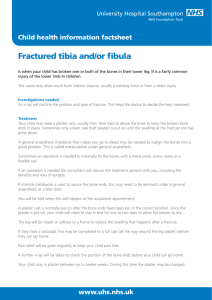
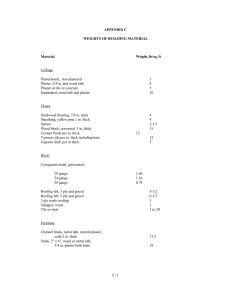
![First Aid Training : Bronze [Power Point]](http://s2.studylib.net/store/data/005424634_1-e0b0e5e602f7c1666ebc2e9ff3f4a1b5-300x300.png)
